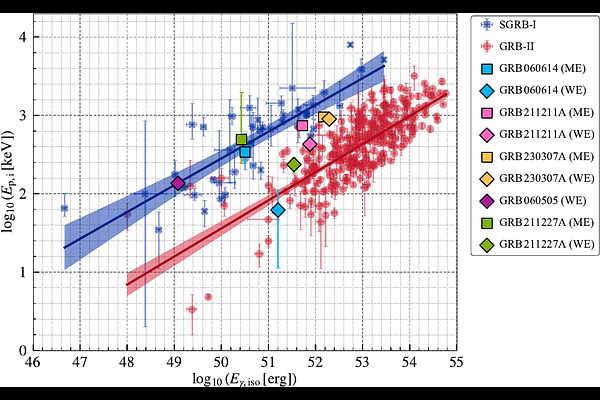Shared Properties of Merger-driven Long-duration Gamma-Ray Bursts

Shared Properties of Merger-driven Long-duration Gamma-Ray Bursts
Yacheng Kang, Jin-Ping Zhu, Yu-Han Yang, Ziming Wang, Eleonora Troja, Bing Zhang, Lijing Shao, Zhuo Li
AbstractThe recent detections of bright optical/infrared kilonova signals following two long-duration gamma-ray bursts (LGRBs), GRB 211211A and GRB 230307A, have significantly challenged the traditional classification of GRBs. These merger-driven LGRBs may represent a distinct GRB population. Since traditional GRB classification methods often struggle to distinguish merger-driven LGRBs from traditional merger-driven short-duration GRBs resulting from compact object mergers and collapse-driven LGRBs produced by massive stars, this work aims to explore the shared properties in terms of hardness, energy, and duration among currently observed merger-driven LGRB events, thereby identifying their observed differences from the traditional GRB population. We collect a sample of merger-driven LGRBs with known redshifts, including observed information on their main emission (ME) and whole emission (WE) phases. Treating ME and WE properties as two independent sets of information, we apply several GRB classification methodologies to explore their potential shared properties. Using the phenomenologically defined Energy-Hardness (EH) parameter, we identify a probable universal linear correlation across merger-driven LGRBs, regardless of whether their ME or WE phases are considered. We propose that such shared properties of merger-driven LGRBs are unlikely to arise from the low-redshift selection effect and they become particularly intriguing when compared with the relatively weak correlations or lack of correlation observed in traditional merger-driven short-duration GRBs (with or without extended emissions) and collapse-driven LGRBs. Our newly proposed correlation highlights the necessity for further investigation into the observations of merger-driven LGRBs and the physical mechanisms underlying the empirical correlation.